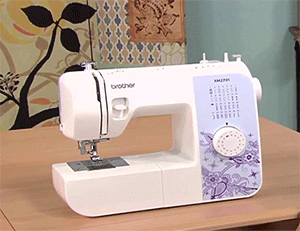I cannot imagine sewing without my serger! If you don’t own one you are missing out on one of the most wonderful machines available to sewers today.
A serger, such as the Bother 1034D, does not replace your sewing machine, but it is a fantastic addition and one you will use with almost everything you sew. It will make every project look clean, neat and professional. In addition, many of the so-called, routine garment making procedures, can be eliminated. A serger can trim and finish the edge of your seams all at once. No longer will you have to fold under the edges of your facings or hems. No more raveling seams. Make a few minor adjustments and you can make a professional looking rolled hem on napkins, table runners, hems or just about anything.
Serging is fast and fun. But, first things first. Your serger will become your best friend – AFTER you become acquainted with it. I know many, many people who have purchased sergers and are so afraid to use them. It takes an investment of time and patience in order to have a long and prosperous relationship.
I purchased my first 3-thread serger over 20 years ago (which I still have and use). I received no training at all and I remember vividly how frustrated I was when it took me an entire day to thread the machine! It was a few years before I learned that there was a particular order in which the threads were to be inserted. Before that, I just struggled and mumbled under my breath until I got things to work as they should. Then, I learned how to tie off my threads and v e r y c a r e f u l l y pulled them through so the threads wouldn’t break.
Sergers have gotten some bad press because of the threading and tension adjustments. Instead of wasting time with trial and error, consult your manual for exact settings. Consider The Complete Serger Handbook — I own this book. It will teach you everything you need to know about sergers. The author, Chris James, says “Give yourself time to develop a ‘serger mode,’ a time to recognize where a serger stitch will replace a sewing machine technique, whether it be for finishing edges, garment construction or decorative work”.
HELPFUL HINTS
Sergers must be threaded in a particular order. Otherwise, the upper and lower loopers will not sew correctly. There is usually a diagram, color coded, on the machine to show the threading order. Just knowing this one fact can save you many minutes, sometimes hours, of frustration.
There is also a procedure known as “tying off” the threads. This means that instead of taking the current thread out of the serger and re-threading, you can simply cut the threads from the spools, add a new spool of thread and tie off the threads, using a simple square knot. Make the knot as tight as you can without breaking the thread. Repeat this for all spools. Then, simply run the serger until all the threads clear the back of the presser foot. I always change the upper and lower looper threads first because they go through the machine without breaking (if you’ve tied a good knot and trimmed the excess thread). Then, tie off the spool or spools that thread the needle(s). Most of the time the thread will break at the eye of the needle. This can cause some problems for you. So, keep an eye on the thread as it approaches the eye of the needle. Then, stop the serger, cut off the old thread and thread your needle(s) with the new thread.
As far as tension – your manual is your best friend with this machine until you are comfortable with how to do it. There will be a guide giving you the exact threading order and tension settings for the number of spools you are using and the type of edge you want. Be prepared to spend a little time getting to know your machine. Don’t give up. It will only take a few times before you are threading and changing tension settings like a pro!
One of my greatest reqrets when purchasing my second serger was that I did not purchase one with the cover stitch feature. It was one of those “I’ll never need this” statements I made. Big mistake! Eventually, I had to purchase another machine – a Cover Stitch Machine!! This has become one of my favorite machines. The cover stitch is the stitch used on almost every knit garment and makes hemming a breeze. It provides a neat and professional hem.
You have probably already figured out that a serger uses a ton of thread. It’s a good idea, then, to have a few different colors of good quality thread on hand. The Maxi lock Serger brand is a high quality, affordable thread that comes in a good selection of colors. And at 3,000 yards per cone it should meet the demands of most of your serging projects. Check the current price for the Maxi-Lock Serger thread at Amazon.com.










